Why Your Brand Needs a Podcast & How to Start One
Thinking of starting your own brand show? Read this to learn how.
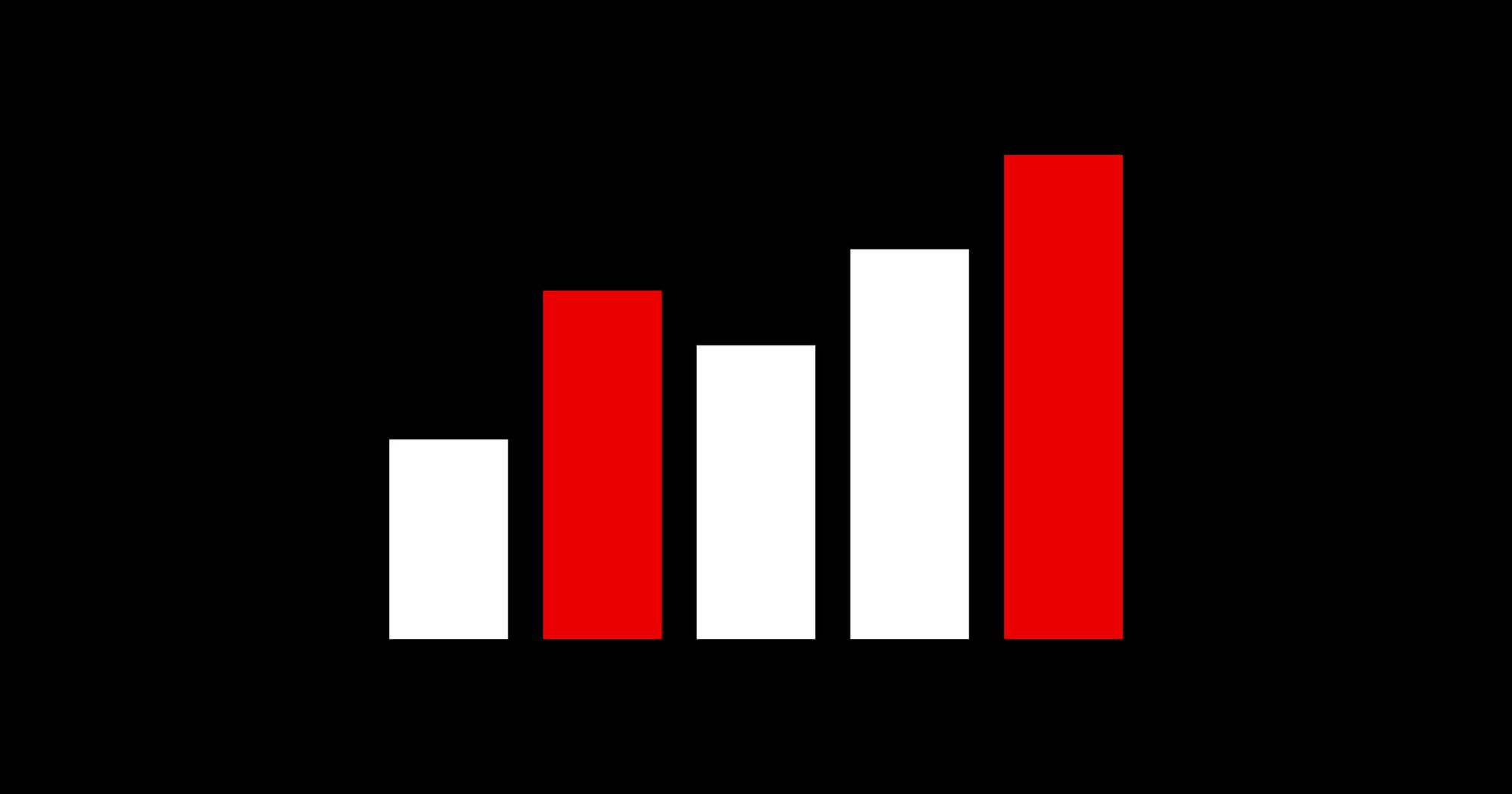
In an era where consumer attention is fragmented across an array of digital platforms, podcasts offer a distinct opportunity for brands to captivate audiences with engaging, long-form content. But why, you might ask, does your business need a podcast? This is exactly what we're about to explore: the benefits that podcasting brings to the table, from establishing authority and community building to driving website traffic and revenue growth.
But let's take a look at these numbers first. In 2022 alone, 62% of US consumers said they were listening to audio podcasts, which is 57% higher than in the previous year. According to Statista, it's predicted that the number of monthly podcast listeners in the US will hit 164 million in the year 2024, so the growth is quite huge.
Businesses are increasingly incorporating podcasts into their marketing strategies. Research indicates that a significant percentage of small and medium-sized businesses are regular podcast listeners, with around 60% of small businesses and 71% of medium businesses tuning in. Moreover, in 2022, 82% of marketers planned to maintain or increase their investment in podcasts or other audio content. Podcast advertising has proven to be effective, with studies showing that it is 30% more trustworthy to consumers than social media advertising. So these statistics pretty much highlight the popularity and effectiveness of podcasts as a marketing tool for businesses. But do you need one?
Does your brand need a podcast?
The age-old question. Or it’s better to say the question of the last few years. Does every business need a podcast? Well, it depends. Consider this scenario: You run a coffee shop that tries to build a local community. You already engage with your customers through social media, events, and perhaps even a newsletter. A podcast could be a nice addition to your content strategy. You could discuss coffee culture, interview locals, and share stories from your customers. It's a way to deepen connections and provide value beyond the cup of joe.
Or let's take another example. Your business is a music distribution studio. In your show, you can feature exclusive interviews with up-and-coming musicians, behind-the-scenes insights into the creative process, and deep dives into industry trends and innovations.
On the other hand, if you're running a corporate law firm specialising in mergers and acquisitions, a podcast might not be the most fitting channel for your business. Your clients likely aren't tuning in for legal advice or discussions on case law. In this case, your resources might be better allocated towards other forms of communication and outreach.
Ultimately, whether a business needs a podcast depends on its goals, audience, and resources. It's about choosing the right tool for the job, whether that's a podcast, a blog, a YouTube channel, or something entirely different. So, before hitting the record button, think if a podcast aligns with your business objectives and how it can add value to your audience's experience.
How a brand starts a podcast in 2024
In 2024, podcasting continues to be a powerful tool for brands to connect with their audience on a deeper level, which we partly demonstrated at the beginning of this piece with stats. We’ve recently made a dedicated guide on how to start podcasting—it’s rather long, so you’d better check it if you need an ultimate resource on that.
But if you prefer a shorter version, here are the takeaways. Or steps.
- Define objectives and audience
Before diving into podcasting, you need to clearly define your business objectives. Are you looking to increase brand awareness, establish thought leadership, drive website traffic, or generate leads? Understanding these goals will shape the content and format of the podcast. And identifying the target audience is crucial for tailoring the content to resonate with listeners.
2. Choose a format and theme
With objectives and audience in mind, the brand should decide on the format and theme of the podcast. Will it be interview-based, storytelling, educational, or a mix of different styles? Selecting a theme that aligns with the brand's values, industry expertise, and audience interests is key to attracting and retaining listeners.
3. Invest in quality equipment and production
Quality audio is essential for a successful podcast, so you should invest in good recording equipment—microphones, headphones, and recording software, to ensure clear sound, but we'll talk about that in a minute. Hiring or training someone with audio editing skills will polish the final product and maintain professional standards.
4. Create compelling content
Once equipped with the necessary tools, it's time to start creating content. Brainstorm topics that are relevant to your audience and industry, aiming to provide value, entertain, or educate listeners. Consistency is key, so establishing a content calendar and sticking to a regular publishing schedule helps build momentum and keep listeners engaged.
5. Promote across channels
Podcast promotion is crucial for reaching a wider audience; otherwise, podcasting won't make any sense, which isn't what you want, considering how time-consuming recording of even one episode might be. Brands can leverage their existing marketing channels, such as social media, email newsletters, blogs, and websites, to promote each episode. You can also repurpose your YouTube videos as podcasts and vice versa! Collaborating with industry influencers or participating in podcast directories and communities can also help increase visibility and attract new listeners.
6. Engage with the audience
Interaction with the audience is a fundamental aspect of podcasting. Encouraging listeners to leave reviews, send in questions or topic suggestions, rate your show in Apple Podcasts and Spotify, and engage on social media builds community and strengthens brand-consumer relationships. And when you respond to feedback and incorporate listener input into future episodes you show that the brand values its audience's opinions.
7. Monitor and adapt
Finally, it's essential to monitor the podcast's performance and adapt strategies as needed. Analysing metrics such as downloads, listens, engagement, and audience demographics provides valuable insights into what's working and what can be improved. Adjusting content, format, or promotion tactics based on this feedback ensures that the podcast remains relevant and continues to grow its audience over time.
How can a podcast help your brand?
Even if a podcast might not be the first thing that comes to mind when you build your marketing strategy, it’s surely a worthy asset. Here’s why.
Podcast builds authority and thought leadership
By regularly sharing valuable insights, expertise, and industry knowledge on your podcast, you position yourself and your brand as authorities in your field. If you want to build trust and credibility among your audience, making them more likely to turn to you for guidance and solutions, podcasting is a perfect choice. This might be especially helpful for B2B brands with complex products and consulting services.
Podcast increases brand awareness
Podcasting provides a platform to reach new audiences and expand your brand's visibility. As listeners discover and subscribe to your podcast, they become more familiar with your brand, leading to increased awareness and recognition in your industry.
Podcast strengthens customer relationships
This is a unique opportunity to connect with your audience on a more personal level. Through engaging storytelling, interviews, and conversations (with clients themselves, too), you can build stronger relationships with your listeners, creating a loyal community around your brand and turning your just-customers into ambassadors and, ultimately, advocates.
Podcast drives website traffic and leads
Including calls-to-action (CTAs) and the direct URL in the description of your show episodes will drive listeners to visit your website, download resources you provide there, or sign up for your email list, thus generating leads that you can nurture and convert into customers over time.
Podcast provides content for repurposing
This is perhaps one of the most valuable assets for your social media manager and the entire content team. You can repurpose podcast episodes into various forms of content, such as blog posts, social media clips, newsletters, YouTube videos, and even eBooks. Why bother? This maximises the value of your podcast content and allows you to reach audiences across different channels and platforms. It's also a way of promoting your show.
Podcast broadens monetisation opportunities
Not all brands do that but, depending on your goals and audience size, there may be opportunities to monetise your podcast through sponsorships, advertisements, affiliate marketing, or premium content offerings. This can provide additional revenue streams for your brand and help offset the costs associated with podcast production.
Essential equipment to start podcasting in 2024
Content is king and quality is queen, so specialised podcasting equipment is vital, even if it doesn’t have to be pricey.
Here's a list of the key setup items needed, and here's the ultimate guide on podcast equipment with options for any budget.
Microphone
Invest in a good-quality microphone to capture clear, crisp audio. A dynamic microphone like the Shure SM7B or a condenser microphone like the Audio-Technica AT2020 are popular choices for podcasting. But before you buy, consider your recording environment and intended use when selecting the type of microphone.
Headphones
A pair of headphones is essential for monitoring audio levels and ensuring sound quality during recording. Closed-back headphones are preferable to minimise audio bleed and provide accurate monitoring. Brands like Sony, Audio-Technica, and Sennheiser offer various options suitable for podcasting.
Audio interface or mixer
An audio interface or mixer is necessary to connect your microphone to your computer and control audio levels. Choose a model with sufficient inputs for your setup and features like phantom power for condenser microphones. Focusrite Scarlett and Behringer are popular brands known for their reliable audio interfaces and mixers.
Pop filter or windscreen
A pop filter or windscreen helps reduce plosive sounds (popping sounds produced by the letter "P" or "B") and minimize breath noises in your recordings. It's an inexpensive accessory that can significantly improve audio quality. Many microphones come with a built-in pop filter, but an additional one can provide extra protection.
Recording solution
Select recording software (Digital Audio Workstation, or DAW) to capture and edit your podcast episodes. Popular options include Audacity (free and open-source), Adobe Audition, Waveroom, GarageBand (for Mac users). Choose a DAW that fits your budget and offers the features you need for editing and post-production.
Computer
A reliable computer is necessary for recording, editing, and storing podcast episodes. Ensure your computer meets the minimum requirements for your chosen recording software and has sufficient storage space for audio files. Both Mac and Windows systems are suitable for podcast production, so choose based on your preference and budget.
Acoustic treatment
Acoustic treatment of your recording space minimises echo and background noise. Acoustic foam panels, bass traps, and soundproofing curtains can help improve the sound quality of your recordings. Start with basic treatment in your recording area and gradually upgrade as needed.
Optional: Mic stand or boom arm. While not essential, a mic stand or boom arm provides stability and flexibility for positioning your microphone. A boom arm allows you to adjust the microphone's position easily, while a mic stand offers a more stationary setup. Choose the option that best suits your recording setup and preferences.
How to record a podcast with Waveroom
If you've decided you're joining podcasting game, it's time to record your first episode, and there's no better tool than Waveroom. Specifically made for podcasters and interviewers, this free online recording solution addresses every need aspiring and seasoned podcasters may have. Waveroom ensures your audio sounds crisp and your video looks good with its 2K video quality and 48 kHz uncompressed audio. Local recording provides high-quality even if there's something wrong with your Internet connection, and multi-track recording allows you to save hours of dauning post-production.
Here's how you can record you brand show with Waveroom, be it an interview, solo talk, or a co-hosted discussion.
- Log in or sign up to your Waveroom account.
- Select your camera, microphone, and headphones in the Devices tab under the video preview.
💡Connect the best microphone and web camera you’ve got to your computer. It will help you get top-notch quality results.
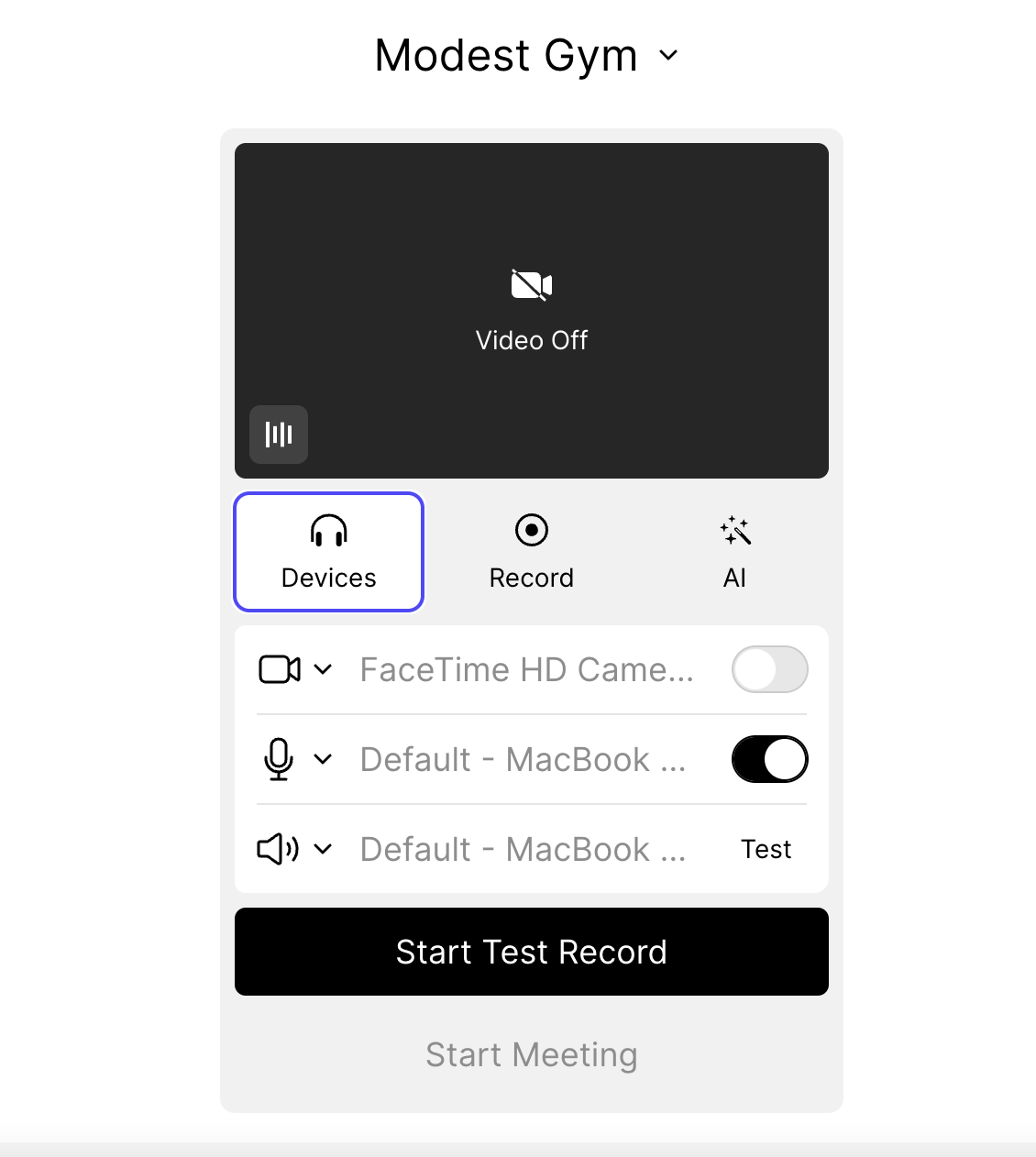
2. Select the video resolution and audio quality in the Record tab. Waveroom records uncompressed 48 kHz audio and up to 2K video.
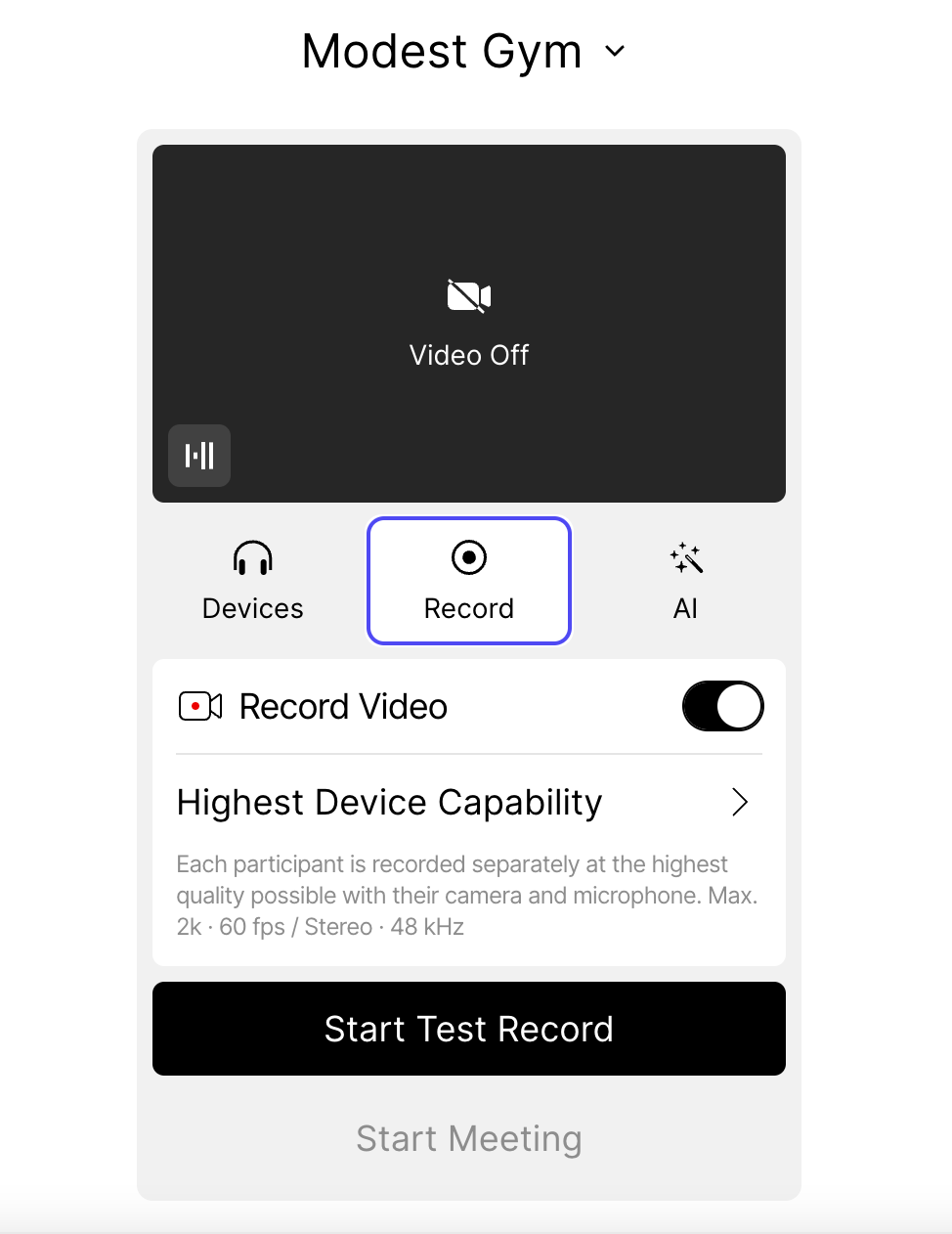
💡If you want to leverage Waveroom's AI tools, open the AI ✨ tab. Waveroom allows you to remove background noise from your show, create its transcript, and summary.
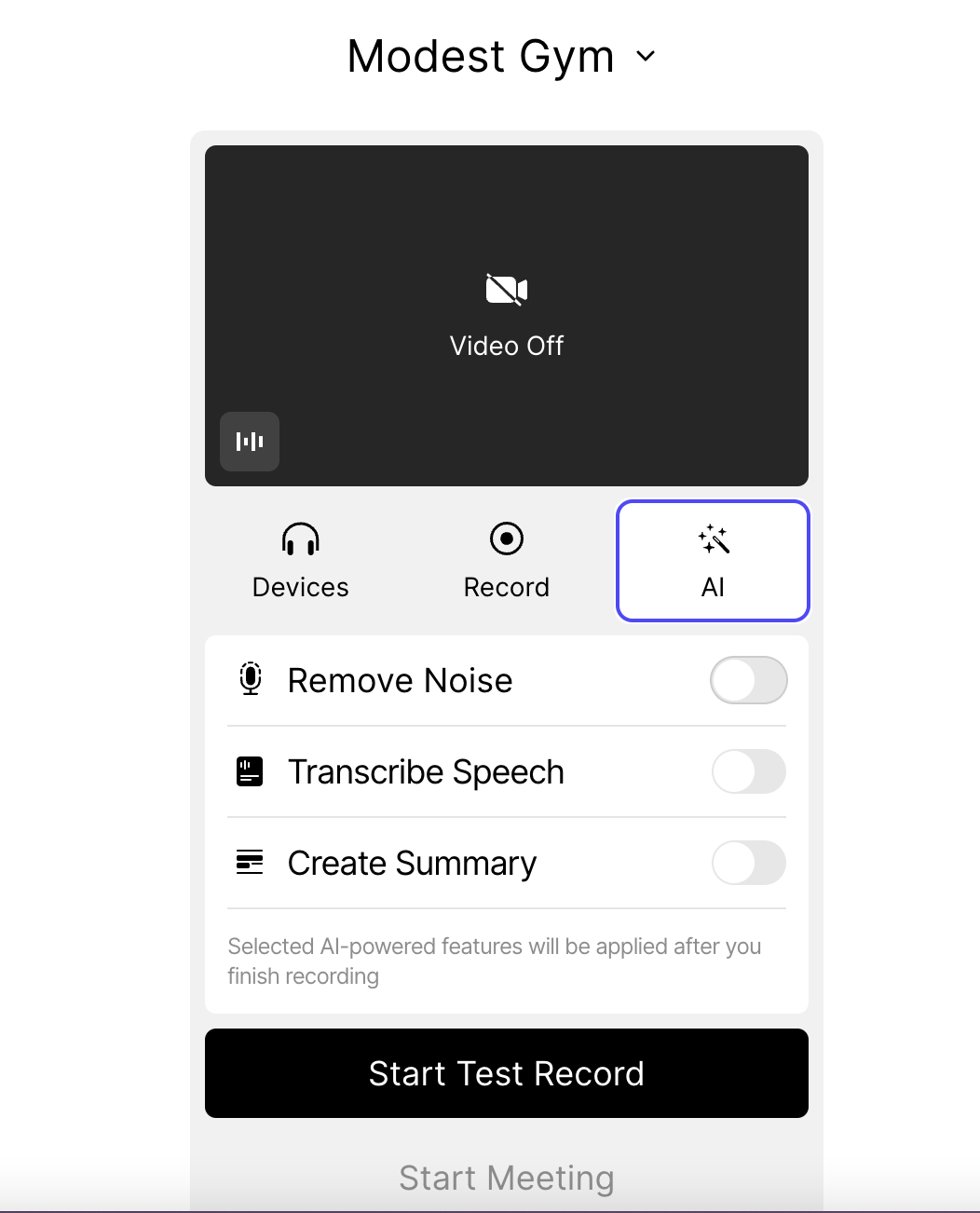
3. Click the Start Meeting button to open your recording room. If you want to test it first, opt for Start Test Record.
4. Click the Record button when you’re ready to start the podcast.
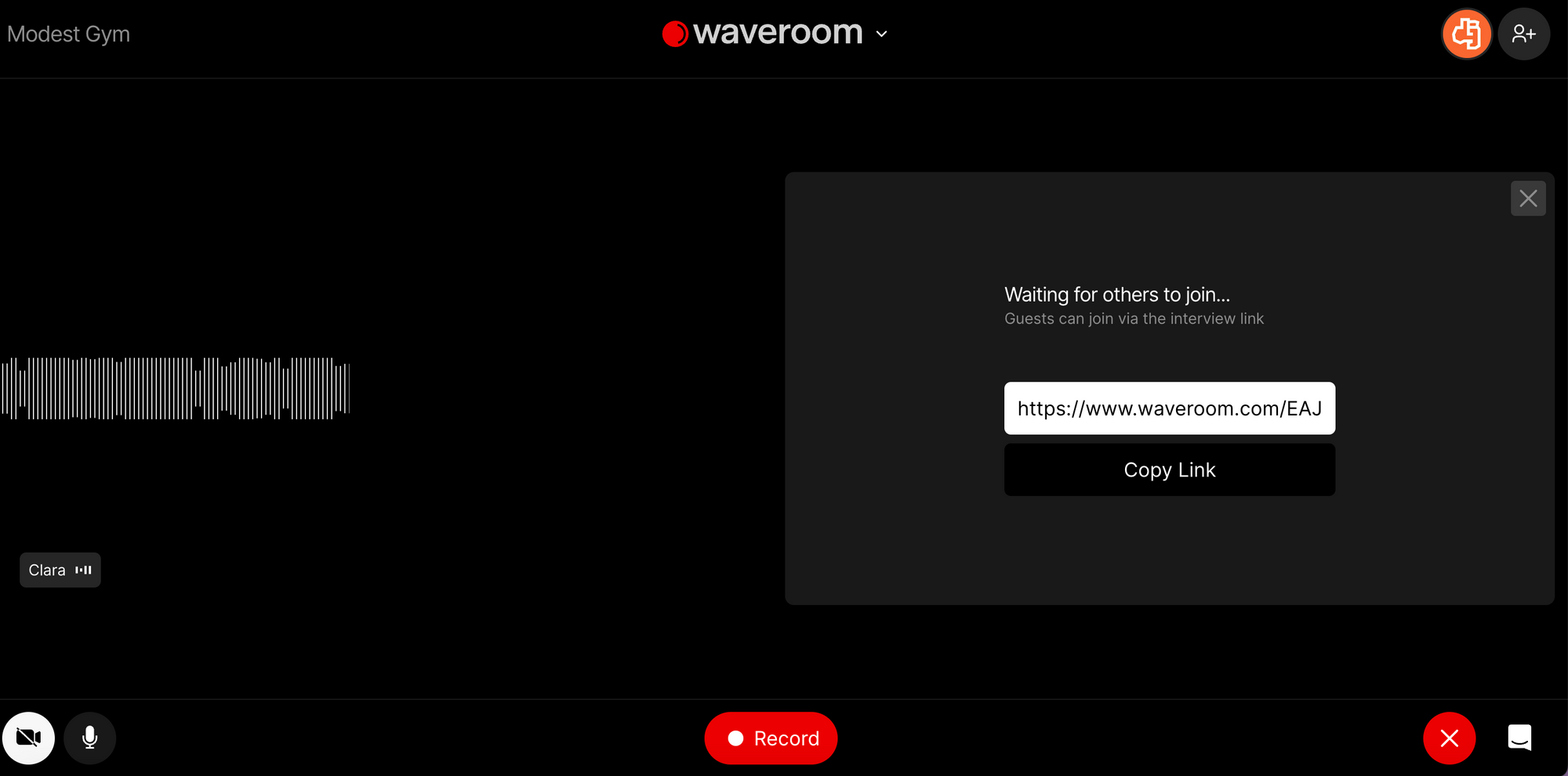
5. When you’re done, click the Stop button to end the meeting.
6. Wait a few seconds while the meeting recording is saving.
7. Once you see the Upload Completed notification at the bottom right corner, click the X sign to leave the meeting.

That’s it! Now you can edit the podcast if needed and upload it to various podcast platforms and your social media accounts.